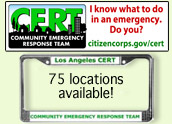2002 Battalion 15 Field Exercise
Reported by Richard WoodThe day started at around 8:00 am on a warm Fall morning, with about 25 stalwart CERT members. None of us had any idea what the morning would bring --- sort of how a field operation is in real life as well.






While we were all milling around, waiting for the event to begin, LAFD Airship 4 came in for a landing. The crew gave us a close-up-and-personal view of their helicopter. They took quite some time to explain who they are, what their mission is, and how they envision CERT members to fit into their operations during a disaster. We learned that the larger Bell helicopters fly with one pilot, a crew chief who is also a pilot, and two firefighter paramedic helitechs. Their training is demanding and rigorously exacting. Our training by them included providing safety to those on the ground by securing a safe perimeter around the helicopter, especially to keep people away from the tail rotor which turns about 30 times faster than the main rotor, rendering it invisible. Even with extensive precautions, people still lose their lives approaching a helicopter from the back, and walking into the tail. "You have no business or need to be behind the back of the side doors unless you are flight crew" was the main message.


The next learning opportunity came by way of the Hazmat squad crew, who explained their mission within normal as well as disaster operations. They also took the time to describe to us what they see as our role. In short, we are the people who will be directing decontaminated victims to the busses for transport, to refreshment and at times triage areas, and the ever important perimeter securing. Our work in a Hazmat environment is to help keep people at a safe distance, "uphill and upwind". It wasn't mentioned specifically, but remember the Rule of Thumb: If you can cover the entire incident with your thumb at arm's length from your upwind and uphill vantage point, you are far enough away. You might think about carrying an inexpensive but rugged pair of binoculars or a monocular in your car and go-kit so you can see placards, general conditions, and count victims from a greater distance.
Next on the agenda was the search itself. The scenario was that there had been a rave party in Chatsworth Park the night before, and 5 teens had not returned home by sunrise. CERT was activated by the Battalion Chief by calling the Battalion 15 Coordinator to get the phone tree started. Individual CERT members arrived between 0800 and 0900 hours, and the Incident Command structure was put into place.
An Incident Commander was appointed by virtue of having been the first to sign in. Traditionally, the Incident Commander is the first on the scene, and his initial staff may consist of the next 4 to 6 people who arrive. On this morning, 4 individuals reported to the Incident Command post, and became the Scribe, Scribe Runner, Logistics, and Map Keeper/Historian. Later arrivals provided the IC with a Staging Manager and individuals to form into teams.
As people arrived, teams of 5 to 7 CERT members were deployed to search. As luck would have it, the first team out found one of the victims in a rather dead-appearing condition. The missing head and the presence of bullet casings were indicative that this was potentially a crime scene. It was duly secured, cordoned off, and two CERT members stood guard awaiting LAPD arrival.
The third team found a victim next to a water tower, and the scenario stated he had injuries. That called for a Stokes litter to be deployed so the victim could be properly packaged and evacuated. Due to time and resource constraints, the medical aspects of the operations were talked about, but not implemented.
Our 4th team was constituted from the members who had comprised Team 1, and were re-deployed to a new and different area. They successfully found their victim, complete with rubber rattlesnake which was activated by a nearly invisible string. If someone knows if we lost a CERT member to mock-snakebite, let us know and we will include that information here.
You might have noticed that there has been no mention of Team 2. Team 2 was last seen in the area below the railroad tracks, near a small building. After there being a rather long wait for Team 2 to return, it was decided that a team was needed to try to discover what had happened with Team 1. We didn't have any teams in reserve at IC, so it was decided that possible living victims were a higher priority than the crime scene, and the two guards were deployed at the command of the IC relayed through the Scribe Runner to leave the dead body and proceed to the place Team 2 had last been seen. After a time they returned and reported no one had been found. Team 2 stated that they had shouted for people all around the area, but did not go into what appeared to them to be a hazardous area. Since they got no response to their calling, they returned. It was in exactly that area, behind the small building and near a culvert, that the entire team was. The scenario had the entire team as victims of a landslide. In retrospect it might have been wise to post a safety officer away from the area, but within hailing distance. Sometimes we do not think that far ahead. That is why we have these training exercises.
Once Team 2 and their 'victim' returned to the IC post, we had a short debriefing with Battalion Chief Coleman. He said he was quite impressed by how well and how competently the
participants conducted themselves. He said he was satisfied that we could and would function well in an emergency, and now he had confidence based on first hand observation that we CERT volunteers
are an asset. A quick but thorough debriefing and critiquing finished the exercise. IC, Scribe, Logistics, and Staging reported what they did, and how the flow worked for them. Team Leaders told us
how the search worked 'in the field'. It was a good way to spend a Saturday morning. If you were there, thank you!! If you were not, please make the effort to respond to the next Training Exercise.
If you are too far away from the northwest San Fernando Valley, think about writing a scenario and have a search, a mass casualty incident, or an earthquake exercise near where you
are.













